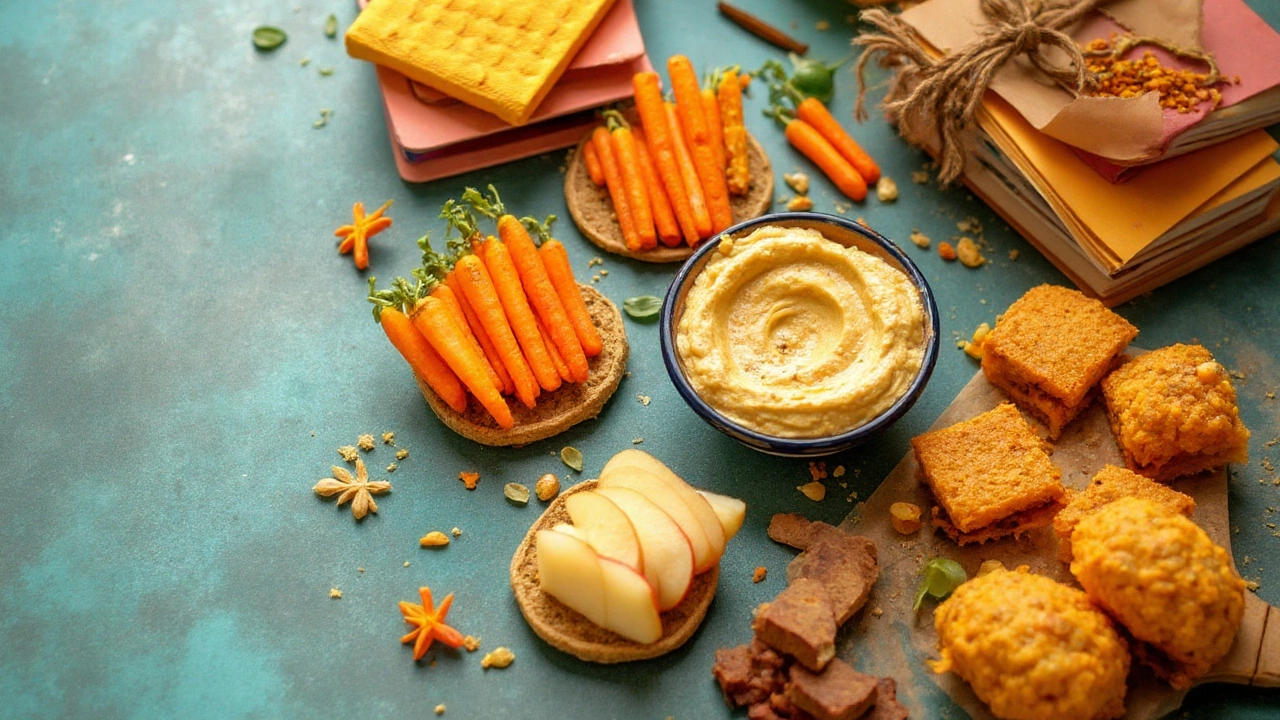If wild hunger starts the minute backpacks hit the floor, you’re not alone. Kids seem to finish a school day with the energy of a cheetah and an appetite to match. But tossing a bag of chips or handing out sweet treats every day gets old fast. What if you had snacks so fun and satisfying, snack time turns into the best part of the afternoon—for the kids and for you? Good news: with just a little prep and creativity, you can whip up after school snacks that strike the perfect balance between quick, healthy, and delicious.
Why After School Snacks Matter More Than You Think
Science doesn’t lie—kids’ bodies run through calories like water through a sieve, especially after a long school day packed with learning, activities, and play. By the time they get home, most kids’ blood sugar is hitting serious lows. If you’re thinking, “No big deal, they’ll eat dinner soon,” here’s a plot twist: afternoon snacks help kids recharge, refocus, and avoid the cranky pre-dinner meltdown.
According to the Academy of Nutrition and Dietetics, kids ages 6-12 need between 1,600 and 2,200 calories a day, spread out over 3 meals and 1-2 snacks. So that midday bite isn’t just a tradition—it’s part of the daily energy equation. Grab-and-go processed snacks are easy, but the sugar crash isn’t worth it. Research published in the journal Appetite in 2023 showed that snacks with protein and fiber—think string cheese, apples, or hummus with veggies—kept kids full longer and helped them focus better on homework.
And let’s get real: the after school snack is a golden opportunity. You can sneak in extra nutrients, introduce new flavors, or get picky eaters on board with healthier bites. Some parents even use snack time to let kids help in the kitchen, building independence and food skills. According to a 2022 survey by the International Food Information Council, 65% of parents said their kids were more likely to try a food if they helped prepare it.
If you’ve got a houseful of allergy concerns, no worries. There are tons of allergy-friendly snack ideas—everything from sunflower seed butter and carrots to gluten-free crackers and dairy-free yogurts. Just read labels and keep a stash of safe go-tos handy. Pro tip: snacks with a combo of carbs, protein, and healthy fats are the hunger busters that last until dinner. For example, a banana with peanut butter or a small turkey roll-up with cheese. That way, kids aren’t hungry again ten minutes later.
Portion size counts for snacks too. Kids’ stomachs are roughly the size of their fists—a great visual guide. Aim for a snack that’s filling, not a meal replacement. Instead of empty calories from candy or chips, give them fuel that lasts. If you’re feeding younger siblings too, bananas, apple slices, and whole grain crackers are perfect choices.
Your kitchen can be stocked for success. Keeping a tray of washed fruit, a basket of whole grain crackers, or cut-up veggies in the fridge means snack time takes seconds—no meltdown required. A bonus? You’ll save money when you avoid expensive packaged snacks or impulse buys.
| Snack Idea | Calories (Avg.) | Main Nutrients |
|---|---|---|
| Apple slices with peanut butter | 150 | Fiber, Protein, Healthy Fats |
| String cheese and whole-grain crackers | 120 | Calcium, Protein, Fiber |
| Fruit smoothie with Greek yogurt | 180 | Protein, Calcium, Vitamins C & D |
| Veggie sticks with hummus | 100 | Fiber, Protein, Iron |
| Banana and nut butter wrap | 160 | Potassium, Protein, Healthy Fats |
| Yogurt parfait with granola | 200 | Protein, Probiotics, Fiber |

Creative Snack Ideas That Kids Will Actually Want to Eat
Let’s face it, nobody craves carrot sticks if they look like sad leftovers. Kids eat with their eyes first. If you can turn snack time into an adventure, you’ll turn even the pickiest eater into a foodie-in-training. Get creative with shapes, colors, and combos—just a five-minute tweak can make all the difference.
Skewers are a snack-time secret weapon. Threading grapes, mini mozzarella balls, cherry tomatoes, and turkey cubes onto a stick makes them way more exciting. Swap deli meat for cooked chicken or tofu for protein variety. You can even theme the skewer to match something they learned in school (like a color-themed skewer after art class).
Dips are snack gold. Hummus, ranch, or guacamole turn anything into dipping fun—kids dig dipping. Serve with bell pepper strips, baby carrots, snap peas, or whole-grain pita chips. You cut the veggies, they do the dipping. Mix things up with fruit dips, like Greek yogurt mixed with a drizzle of honey and cinnamon for apple slices.
Try building snack platters with a mix of flavors and textures: cubes of cheese, crackers, turkey roll-ups, and berries. If you’re short on time, grab-and-assemble foods like rice cakes with nut butter and banana, or English muffins topped with marinara and cheese for mini “pizzas” that toast up in two minutes. Kids can help assemble them, which makes them more likely to eat—and less likely to ask for candy.
What about sweets? You don’t have to ban them, just build them smarter. Frozen banana slices dipped in a little dark chocolate and rolled in chopped nuts hit that sweet spot without the sugar overload. Or freeze low-sugar yogurt into little dots with blueberries for an ice cream vibe (and zero artificial stuff).
Some afternoons call for a warm-up. Air-popped popcorn sprinkled with parmesan, olive oil, or a pinch of cinnamon sugar is a fast crowd-pleaser. Popcorn is a whole grain, by the way—bonus points for fiber. Microwave quesadillas stuffed with black beans and cheese or a quick egg muffin you make ahead over the weekend can do double duty as a snack and lunchbox hero.
If you’re feeding a crew with allergies, sunflower seed butter on rice cakes, oat-based energy balls, or roasted chickpeas are safe, satisfying, and easy to prep ahead. Plant-based and vegan snacks are booming, too—vegan yogurt, edamame, and fruit bars with no added sugar are all smart bets.
Mix and match your snack game by keeping these staples on hand: granola bars with real ingredients, low-sugar yogurts, fresh berries, raw nuts, and mini whole-grain bagels. Rotate flavors each week so kids (and you) never get bored. Even mini tacos from leftover dinner or a smoothie packed with fruit, spinach, and protein powder can keep kids full and happy.
Don’t underestimate the power of fun presentation. Use bento-style boxes, colorful plates, or even a muffin tin to serve a variety of tiny snacks at once. Let kids “shop” the fridge for toppings or mix-ins. The more control they have, the more interested they’ll be—science backs that up.
And because the clock’s always ticking, here are ten fast ideas for busy afternoons:
- Pretzel sticks with cheese cubes
- Mini rice cakes with almond butter and strawberries
- Turkey and cheese roll-ups
- Veggie sushi rolls (just wrap with seaweed, cucumber, and avocado!)
- Low-sugar granola with Greek yogurt
- Homemade trail mix (seeds, popcorn, a couple of chocolate chips)
- Chilled applesauce with cinnamon
- Sliced veggies with ranch or hummus
- Fresh fruit kabobs
- DIY mini pizzas on crackers
Here’s a little-known bonus: snacks can help improve your child’s mood and even their sleep. If the after school munchies include magnesium-rich foods like nuts, seeds, or dark chocolate, you can give them a leg up for a chill evening. That’s some serious snack magic.

Simple Tips for Nutritious After School Snacks
Good snacks are a game changer, but the real win is keeping it easy. One trip through the grocery store and you’ve got what you need for a whole week. Look for real foods—grab-and-go but with ingredients you recognize. If a snack has more than 5 ingredients and you can’t pronounce half, keep walking.
One smart move: batch-prep on the weekend. Slice up carrots, celery, cucumbers, and bell peppers and put them into grab bags in the fridge. Wash grapes, strawberries, and blueberries and toss them in single-serving containers. Portion out nuts, popcorn, or trail mix into snack-size bags. That way, kids don’t just grab what’s closest—they reach for what’s ready.
For the snack-obsessed, try a rotation chart. Plan a few snacks each week and let the kids vote on their favorites for next time. This avoids the “I’m bored of this” whine by Wednesday. Plus, studies show that kids given some choice are less likely to binge on sweets.
Cheese sticks, yogurts, and hard-boiled eggs are fridge MVPs. They last all week, travel well, and fill up growing tummies. If your child’s into smoothies, keep frozen fruit, spinach, or kale on hand. Just blend with milk or a dairy-free alternative and toss in a scoop of protein powder for a power snack that doubles as breakfast or dessert.
Save money and control the ingredients by making your own snack bars. Combine rolled oats, a touch of honey, chopped nuts, seeds, and mini chocolate chips. Press into a baking dish and refrigerate—slice and serve. No weird preservatives, no excess sugar.
Don’t skip hydration, either. Dehydration can make kids cranky and decrease focus as much as hunger can. Keep reusable water bottles within reach, and toss in frozen fruit, citrus slices, or cucumber for a fresh twist. Skip the sugary juice boxes and sodas—real fruit adds enough flavor without a sugar ride.
Some foods can do double-duty for kids with activity-packed afternoons. Good old-fashioned PB&J (on whole grain bread and with a low-sugar jam) is still a champion. It’s filling, easy, and you can freeze them in advance for super-busy days. Yogurt parfaits with fruit and crunchy granola hit the sweet spot, too.
The secret sauce for the after school snacks game: balance. Pack a mix of carbs for fast energy, protein for staying power, and a little healthy fat. That could mean apple slices with peanut butter, whole-grain pita with hummus, or cottage cheese with peaches.
Don’t let snack time become screen time. Serve snacks at the table, not in front of the TV, to encourage mindful eating and better digestion. Eating together—even just for a snack—helps you check in about your child’s day and reinforces healthy habits.
If allergy restrictions are in play, don’t sweat it. Creative swaps like seed butter, coconut yogurt, or gluten-free crackers put almost every snack idea within reach. School-safe snacks (nut-free, dairy-free, gluten-free) are easier to find than ever in stores, and you can easily tweak recipes to fit your needs.
Try turning snacks into a quick game. Blind taste tests, snack-building challenges (“who can build the tallest cracker tower?”)—anything to make it fun. Kids remember food experiences, and that positive association can nudge them toward better choices later.
Think about leftovers, too. Leftover roasted sweet potatoes, bits from dinner, roasted chickpeas, or cooled pasta tossed with veggies and dressing can all play snack duty. Getting creative with these keeps waste down and adds variety.
With just a bit of planning, you can turn after school snack time from a stress point to a high point, fueling kids' bodies and minds—not just until dinner, but for a lifetime of healthy choices.


